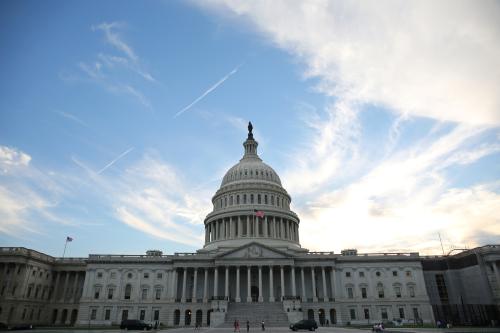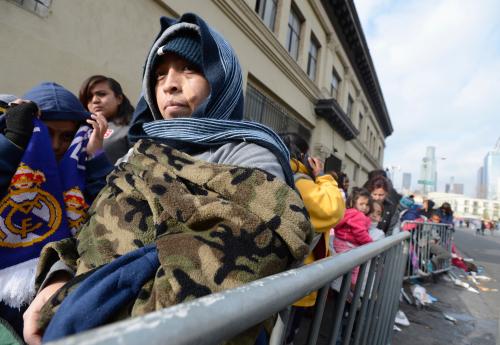The GOP tax package is anti-growth in at least one respect: It’s likely to cut public spending devoted to investing in the future. The bills passed by the House and Senate eliminate or sharply curtail the federal income tax deduction for state and local income and property taxes. In addition, both plans would cut some current tax preferences that make college and graduate school more affordable. Under the House tax plan, for example, the favorable treatment of graduate tuition waivers would be eliminated, forcing graduate students to pay federal income taxes on the tuition waivers they receive as an inducement to attend graduate school.
Although the effects of the tax changes may be unintended, these features of the GOP plans can discourage state and local governments from maintaining the taxes that fund schools and public universities and may deter young adults from enrolling in graduate school, especially in science and engineering where tuition waivers are common. States that levy high income or property taxes to fund their schools and colleges will face greater pressure to cut those revenue sources if highly taxed residents cannot deduct their local taxes from federally taxed income.
We don’t yet know what provisions of the House and Senate tax packages will survive when the two Houses negotiate a final tax package. We do know, however, that the final law will cut federal revenues by at least $1 trillion over the next decade. The likely impact of this loss will be to reduce federal outlays. Under current budget rules, in fact, the Office of Management and Budget will be obliged to issue a sequestration order to reduce expenditures in designated spending accounts to make up much of the expected revenue loss. Some spending items, such as Social Security, are exempt and others, notably Medicare, cannot be cut more than a specified percentage amount. This means that other budget items must be cut by larger proportional amounts or eliminated altogether. One of the spending accounts targeted for automatic cuts is student loans. When the sequester rule was adopted by Congress, it was thought that the automatic cuts would be so objectionable to both parties that lawmakers would either avoid raising the deficit or enact a law that waives sequestration.
If the past is any guide, domestic discretionary spending will be especially vulnerable to future cuts.
If the past is any guide, domestic discretionary spending will be especially vulnerable to future cuts. This category of federal spending includes outlays on health care research, transportation investment, education and training, and investments in science, energy, and the environment, including investments in basic research. Thus, not only will the tax package change incentives for investments in schooling by states, local governments, and the nation’s graduate students, it will indirectly deprive federal agencies of funding that has historically supported investment in infrastructure and research.
Recent trends in public investment have not been encouraging. Measured in constant dollars, gross government investment, aside from national defense, has fallen more than 10 percent since the end of the last expansion in 2007. The drop was proportionally even bigger if we focus on investment by state and local governments. (Federal nondefense investment was lower, too, but the drop was much smaller in percentage terms.) Public investments fuel future growth by improving roads, public transportation, ports, sewage and water systems, and public buildings and labs. Measured as a share of the U.S. economy, combined federal, state, and local investment spending hit a six-decade low in 2016 (Chart 1). If the public investment share in GDP had been as high in 2016 as it was on average over the period from 1980 to 2007, federal, state, and local investment would have been about one-fifth higher.
An overwhelming share of education spending is excluded from our estimates of government investment spending. Most educational spending takes the form of compensation for the teachers and staffs of schools and colleges. Nonetheless, like infrastructure spending, outlays on education represent future-oriented investments. The biggest payoffs from the spending will occur in the future, possibly the distant future. Here, too, the trends in public spending have been discouraging. Spending per pupil on youngsters enrolled in K-12 public schools reached a peak in the 2008-2009 school year. According to U.S. Department of Education statistics, spending has declined noticeably since then. The 2013-2014 school year is the most recent one for which the Department has published estimates. Current spending in that academic year was $11,800 per pupil, or about 4½ percent below the comparable level four years earlier (Chart 2).
Unhappily, the trends in public spending on undergraduate education are, if anything, even worse. According to estimates by the Center for Budget and Policy Priorities, state-level outlays on public 2- and 4-year colleges dropped $8 billion between 2008 and 2017. The cuts affected public institutions in nearly all states. Per-student spending fell in 44 states and increased in just 5. In 8 states, per-student expenditures fell more than 30 percent. The spending picture has improved in the past couple of years, but public funding covers a substantially smaller share of undergraduate costs than was the case a decade ago. Students and their parents pay for an increasing share of the cost of financing public higher education. The results have included higher tuition, higher net costs to families after accounting for financial aid, and lower enrollments than we would have seen if state appropriations had remained strong.
Public investments in the future have been shrinking as a percentage of government budgets and the overall economy. This was true even before Congress launched the debate over how to overhaul the tax code. Based on the versions of the GOP tax plan passed by the House and Senate, it seems likely that the direct and indirect effects of any new tax law will tend to reduce public investments still further. Even if the tax changes induce some businesses to boost private company investments, the resulting gains must be set against the future losses we should expect from shrinking public investment. GOP lawmakers are no doubt confident the gains from extra private investment handily outweigh the losses from lower public investment. I don’t share their confidence.
The Brookings Institution is committed to quality, independence, and impact.
We are supported by a diverse array of funders. In line with our values and policies, each Brookings publication represents the sole views of its author(s).






Commentary
Drop in public investment picks up steam under GOP tax plan
December 6, 2017